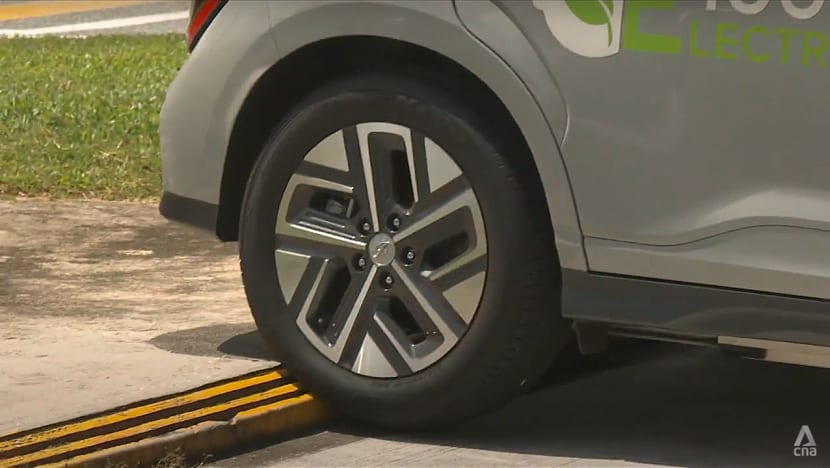‘World’s worst drivers’: Are Singaporeans as bad as they proclaim each other to be?
Singaporean drivers have a notorious reputation, but are bad driving skills or a poor driving culture the main culprit? The programme Talking Point sends its hosts to find out and asks viewers which group of drivers are the worst.

Johnathan Chua, co-host of The Daily Ketchup podcast, allowing himself a wry smile as he retakes his driving test under the watchful eye of a ComfortDelGro Driving Centre instructor.

This audio is generated by an AI tool.
SINGAPORE: What lies at the junction of a fast-paced lifestyle, dense population and an ingrained sense of competitiveness? Bad drivers — or, apparently, the average Singaporean motorist.
Singaporean drivers have no shortage of disparaging nicknames for each other, from lane hog to speed demon to road rager.
But perhaps none sting as much as “the worst drivers in the whole world”, a label that went viral on TikTok after Wendi Chan called out fellow motorists last September.
“Whenever a person (gives the) signal … to (switch to) your lane … the car behind will speed up,” the entrepreneur lamented. “So you can’t get in.”

The statistics seem to support her claim: The number of traffic accidents resulting in fatalities increased by 26 per cent from 104 cases in 2022 to 131 last year, exceeding the pre-pandemic figure of 117 cases in 2019.
With 13.64 deaths per 100,000 vehicles, Singapore has a higher fatality rate than many other countries. It is more than three times the rate in Great Britain and four times that in Japan.
Some experts suggested that one reason is Singapore’s population density. “(Accidents here) tend to be multi-car collisions with people inside,” said Sgcarmart editor Desmond Chan, 34.
But bumper-to-bumper traffic is not the only factor contributing to the rise in road accidents causing deaths or injuries. Driving skills and attitudes play a role in sullying Singaporean drivers’ reputation.
The programme Talking Point put three of its hosts — Munah Bagharib, Shrey Bhargava and Steven Chia — behind the wheel to investigate these issues and asked viewers which Singaporean drivers deserve to be dubbed “the worst”.
BAD HABITS EXPOSED, DRIVING RETESTS FAILED
After three days of patrolling the roads, the hosts returned with the following field notes:
Bhargava, who took on the morning rush hour in the Central Business District, observed frequent and rapid lane changes on roads so packed that vehicles often got stuck in the middle of a junction.
Drivers entering these intersections on a green light were creating a “pretty dangerous” situation as they waited for traffic to move and the light turned red.
Chia, who tackled lunchtime traffic, noticed constant construction projects adding to congestion, resulting in impatient drivers. While not many drivers stopped to let him filter in, he admitted that he “probably wouldn’t” have let others cut in either.
WATCH: Why are we bad drivers? Is it attitude or skills? (41:05)
Lastly, on patrol in the evenings, Munah also observed drivers frequently changing lanes without signalling. “This guy beside me … (was) swerving from lane to lane,” she remarked, adding that this behaviour was particularly common late at night.
It all seemed to Wendi Chan, 51, that Singaporean drivers tended to be impatient and ungracious.
“It’s a well-known, unsaid fact in Singapore that if you want to go into other people’s lane, instead of signalling you should just sneakily … go in,” she said.
Desmond Chan suggested that such behaviour stems from living in a small country, where the roads “aren’t very extensive” and getting anywhere takes an hour at most. Therefore, people have become so protective of their time that even a small delay feels significant.

Additionally, the high cost of owning a car in Singapore may have fuelled a sense of highway hubris.
“(It’s) that kind of mindset that, ‘Hey, I paid so much to drive this car, why should I give … way (to you)?” said Jayjay Lin, head of stories and branded content at Sgcarmart.
Daniel Lim, co-host of The Daily Ketchup podcast, agreed that driving habits in Singapore are influenced more by the driving culture than any lack of skill.
“If we were waiting for the pedestrians to get (on) the kerb, the people behind us would’ve been (honking) and impatient already,” the 32-year-old said. “I feel like I drive with the judgement of the person behind me in mind.”

But is it simply poor etiquette or have drivers also overestimated their skills?
To find out, Lim, his fellow podcast host Johnathan Chua, Wendi Chan and Chia retook their driving tests — a decade or more since they first passed — to see how they measured up.
To pass, candidates must receive 18 demerit points or fewer. Certain infractions, such as mounting a kerb or running a red light, result in an immediate failure. And all four participants failed, averaging 23.5 points and incurring multiple immediate failures.
The most common mistake among the group was failing to stop before the stop line. And even seasoned drivers like Chia and Wendi Chan, each with over 30 years of experience, mounted the kerb.

Chua, 34, who was “so confident” in his parallel parking skills, ended up with the most demerit points (40) and two immediate failures.
It stands to reason that many other Singaporeans’ driving techniques may not measure up, especially when a significant period has elapsed since they had driving instruction.
WOMEN NOT THE WORST, SAY VIEWERS
When Talking Point polled about 2,000 viewers on who they thought were the worst drivers, there were nearly 100 more votes for women than men, reinforcing the stereotype of women as less-skilled drivers.
Claire Jedrek, Singapore’s first female race car driver, offered this perspective: That men may be better drivers because, statistically, many of them spend more time behind the wheel, which gives them more practice.

They also benefit from having a better understanding of car mechanics, given that it is a male-dominated interest, the 41-year-old added.
More time on the roads, however, may lead to more road accidents. The World Health Organisation reported last December that men are three times more likely than women to be killed in traffic accidents.
Bhargava and Munah were drawn into the gender debate when they participated in a driving simulation with real-life accident scenarios — with Bhargava ending up having seven “accidents”, while Munah had four.
“I do notice a lot of men being more aggressive on the roads,” Bhargava said. “They try to ‘race you’ or they try to … speed up to you to say something.”
Listen to Deep Dive:

The gender beliefs are ingrained, said Munah, so when a woman makes a mistake on the roads, the stereotype is reinforced. Mistakes made by men, however, are often seen as individual issues rather than a reflection on their gender.
Still, only 21 per cent of respondents in the poll voted for either male or female drivers, while 36 per cent chose luxury vehicle drivers and 43 per cent selected private hire and taxi drivers as Singapore’s worst motorists.
Taxi driver Harry Ng, 66, attributed the poll results to the visibility and ease of recognition of hired drivers on the roads.
Given their responsibility for passenger safety, the reality is different from perception, argued private hire car driver Peter Jalal, 64. “We have to bring them from point A to point B (in) the safest way (by) driving safely.”

But at the same time, he acknowledged, some drivers may rush demanding passengers to their destinations as they are worried about receiving a poor rating.
It should be noted, however, that taxi and private hire drivers must do a refresher course every six years to retain their vocational driving licence.
“It’s a timely reminder that after driving for a number of years, … (there are) things that you should remember,” said private hire car driver Justin Lim, 54.
REVISITING DRIVING SCHOOL
Would a similar refresher course benefit regular, non-vocational drivers? Jonathan Paul, also from The Daily Ketchup podcast, thinks so.
“I have a grandma who’s about 84, who still drives. … I’ve also seen other elderly drivers who are falling asleep at the wheel or … not really following the rules,” said the 33-year-old.

Lin from Sgcarmart felt that driving schools could focus more on teaching road etiquette in the first place, rather than just driving skills.
“When we go to a driving school, we learn how to parallel park exactly in the lot as the driving teacher suggested, but not so much how to behave out on the road,” he said.
Currently, what some driving schools do offer are defensive driving courses — optional programmes for experienced drivers to enhance their skill in handling other road users and potentially hazardous situations.
Students attend a theory session followed by a practical assessment to determine their risk level — low, medium or high — for potential accidents.

Chia, who received a high-risk score, reflected: “Before I go around asking why (we are) bad drivers, maybe I first need to ask, ‘How do I become a better driver?’”
Jedrek has an answer to that question, based on her racetrack experience: “The number one thing that I learnt that made me a better driver was letting go of ego.”
Watch the full Talking Point episode here. The programme airs on Channel 5 every Thursday at 9:30 p.m.


















